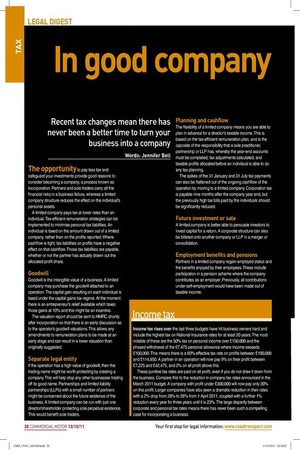In good company
Page 23

Page 24

If you've noticed an error in this article please click here to report it so we can fix it.
Recent tax changes mean there has never been a better time to turn your business into a company
Words: Jennifer Bell
The opportunity to pay less tax and safeguard your investments provide good reasons to consider becoming a company, a process known as incorporation. Partners and sole traders carry all the financial risks in a business failure, whereas a limited company structure reduces the effect on the individual's personal assets.
A limited company pays tax at lower rates than an individual. Tax-efficient remuneration strategies can be implemented to minimise personal tax liabilities. An individual is taxed on the amount drawn out of a limited company, rather than on the profits reported. Where cashflow is tight, tax liabilities on profits have a negative effect on that cashflow. Those tax liabilities are payable, whether or not the partner has actually drawn out the allocated profit share.
Goodwill
Goodwill is the intangible value of a business. A limited company may purchase the goodwill attached to an operation. The capital gain resulting on each individual is taxed under the capital gains tax regime. At the moment there is an entrepreneur’s relief available which taxes those gains at 10% and this might be an incentive.
The valuation report should be sent to HMRC shortly after incorporation so that there is an early discussion as to the operator’s goodwill valuations. This allows any amendments to remuneration plans to be made at an early stage and can result in a lower valuation than originally suggested.
Separate legal entity
If the operation has a high value of goodwill, then the trading name might be worth protecting by creating a company. This will help stop any other businesses trading off its good name. Partnerships and limited liability partnerships (LLPs) with a small number of partners might be concerned about the future existence of the business. A limited company can be run with just one director/shareholder protecting sole perpetual existence. This would benefit sole traders.
Planning and cashflow
The flexibility of a limited company means you are able to plan in advance for a director's taxable income. This is based on the tax-efficient remuneration plan, and is the opposite of the responsibility that a sole practitioner, partnership or LLP has, whereby the year-end accounts must be completed, tax adjustments calculated, and taxable profits allocated before an individual is able to do any tax planning.
The spikes of the 31 January and 31 July tax payments can also be flattened out of the ongoing cashflow of the operation by moving to a limited company. Corporation tax is payable nine months after the company year end, but the previously high tax bills paid by the individuals should be significantly reduced.
Future investment or sale
A limited company is better able to persuade investors to invest capital for a return. A corporate structure can also be billeted onto another company or LLP in a merger or consolidation.
Employment benefits and pensions
Partners in a limited company regain employed status and the benefits enjoyed by their employees. These include participation in a pension scheme where the company contributes as an employer. Previously, all contributions under self-employment would have been made out of taxable income.
What happens on incorporation?
When you transfer your business to a company, work-inprogress, debts and other assets can be sold at their book value so no taxable profit is generated from the sale. Fixtures and equipment are also sold at their book value, but for tax purposes, they transfer the tax written down value. Again, no tax charges arise if the correct process is followed.
It may not be wise to transfer your business premises to the company. There are several tax issues to consider, including capital gains tax, VAT, stamp duty land tax and inheritance tax. With careful planning, it may be possible to move the property into the new company without paying tax, but each case needs to be considered on its merits.
Finally, there is the question of goodwill, which can be sold to your company at its market value or any of the lower amounts you choose. Goodwill is value, but taking the overall value of your business, less the value of tangible and monetary assets.
If the goodwill was created after 1 April 2002, the company is given tax relief for the cost of the goodwill over its useful life, generating 10 to 20 years. The downside to selling goodwill is there will be capital gains tax to pay by the partners, but this should be only 10% due to entrepreneur's relief.
Using the director's loan account
The company now owes the former partners for the assets that have been sold to the company and therefore a loan account is generated. This can provide a good opportunity to save tax because it can be used as a substitute taxable income for a tax-free loan account on the basis of drawings, so long as the loan account lasts. As a director and shareholder of your own company, you could draw your personal income from the company in the following ways to maximise the tax savings: • take a basic salary of £136 per week or £7,072 per year; • take monthly dividends of £2,655 or £31,860 a year;
• then take the balance as loan drawings tax-free. ■
• More information: contact Jennifer Bell, head of corporate and commercial law, at Backhouse Jones Solicitors, jennifer.bell@backhouses.co.uk www.backhousejones.co.uk













































